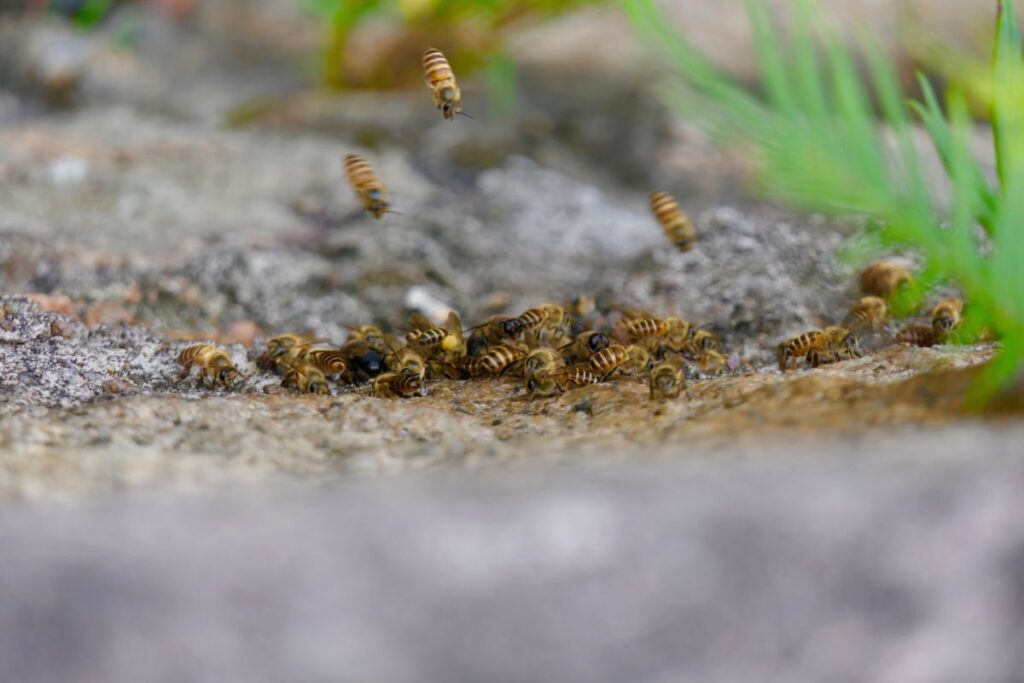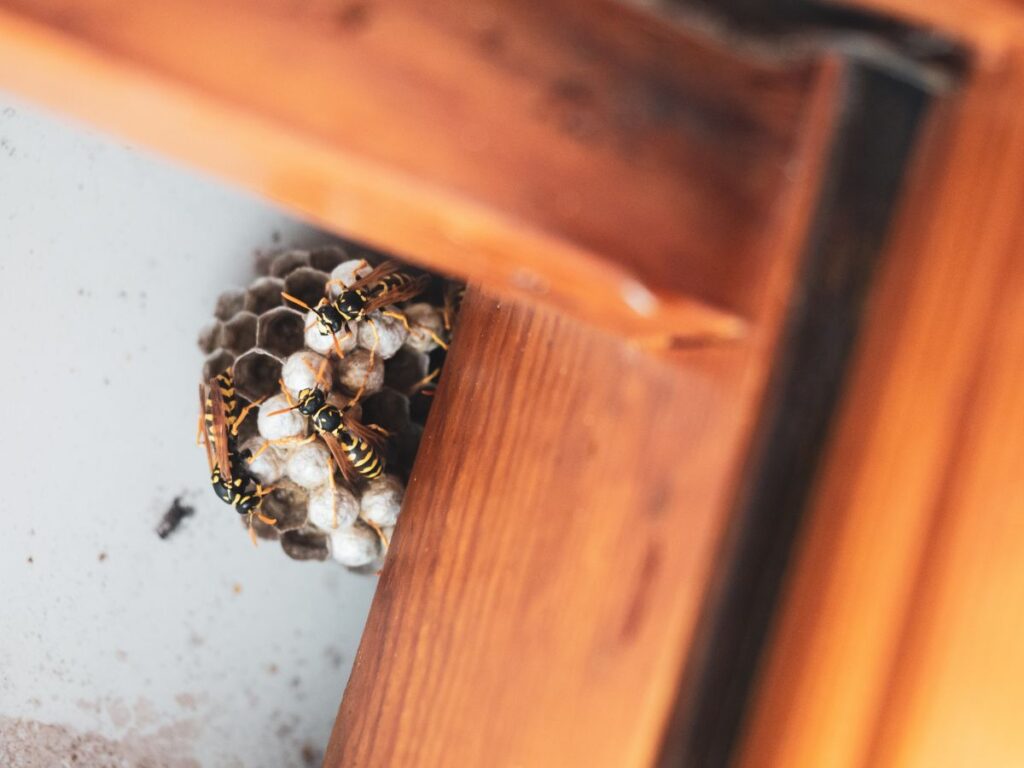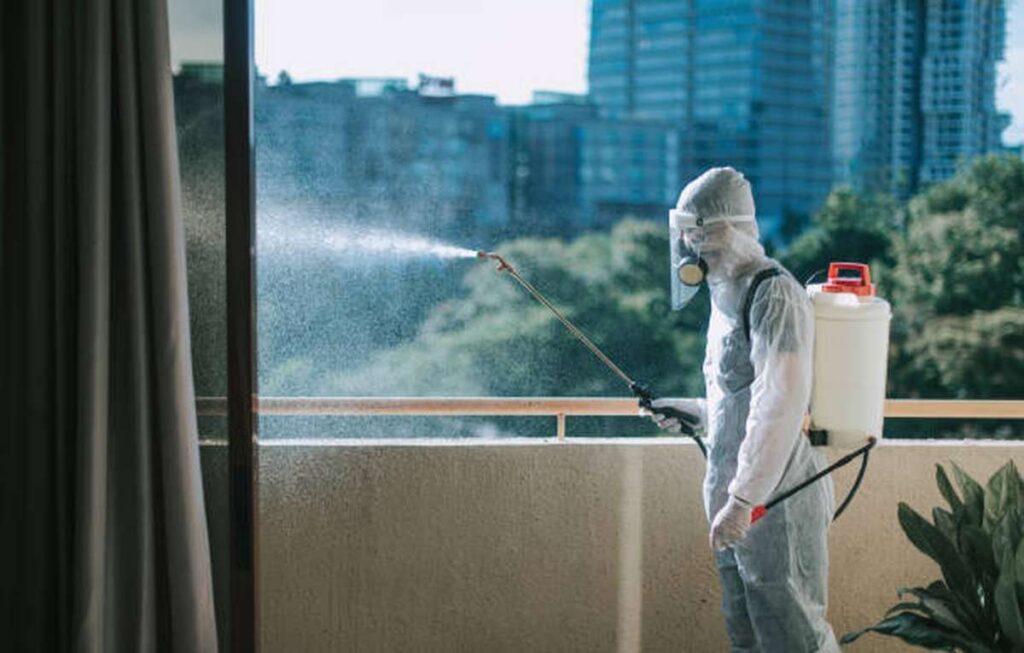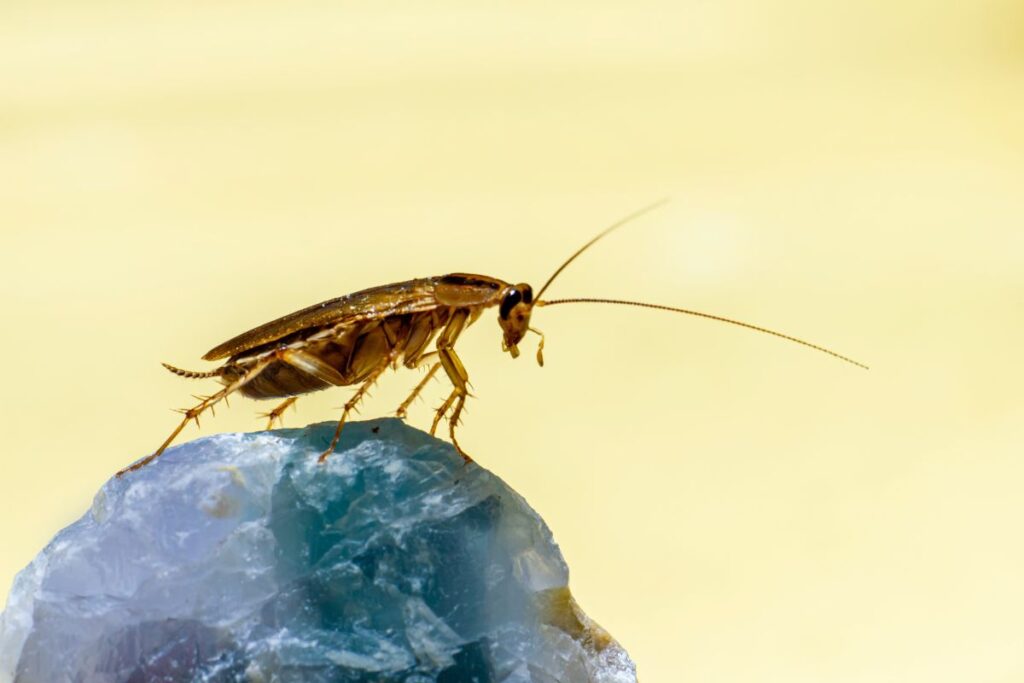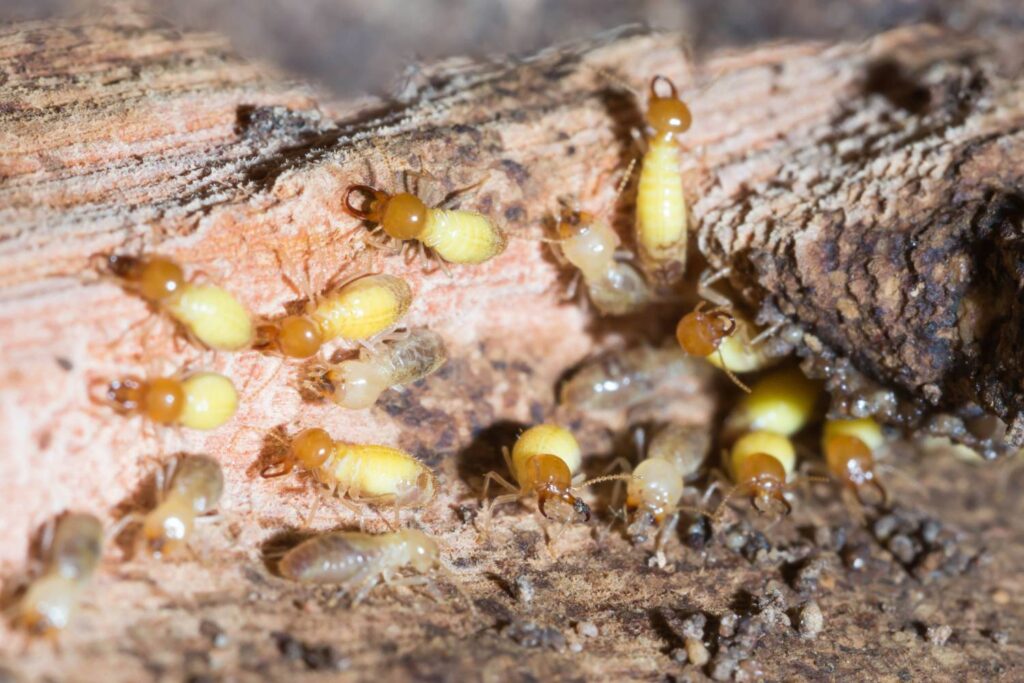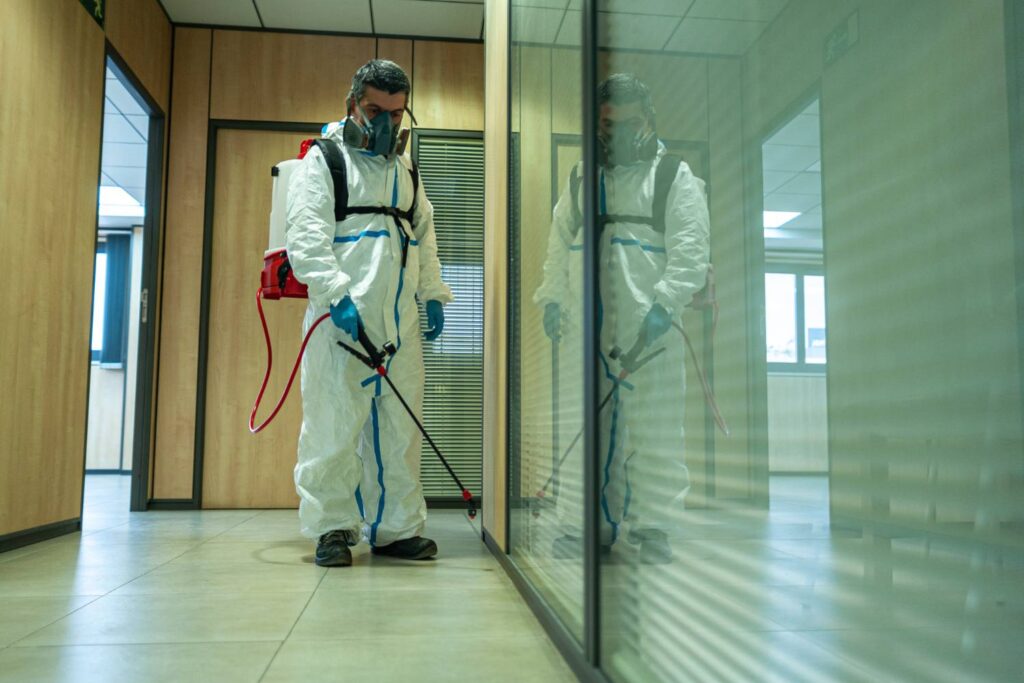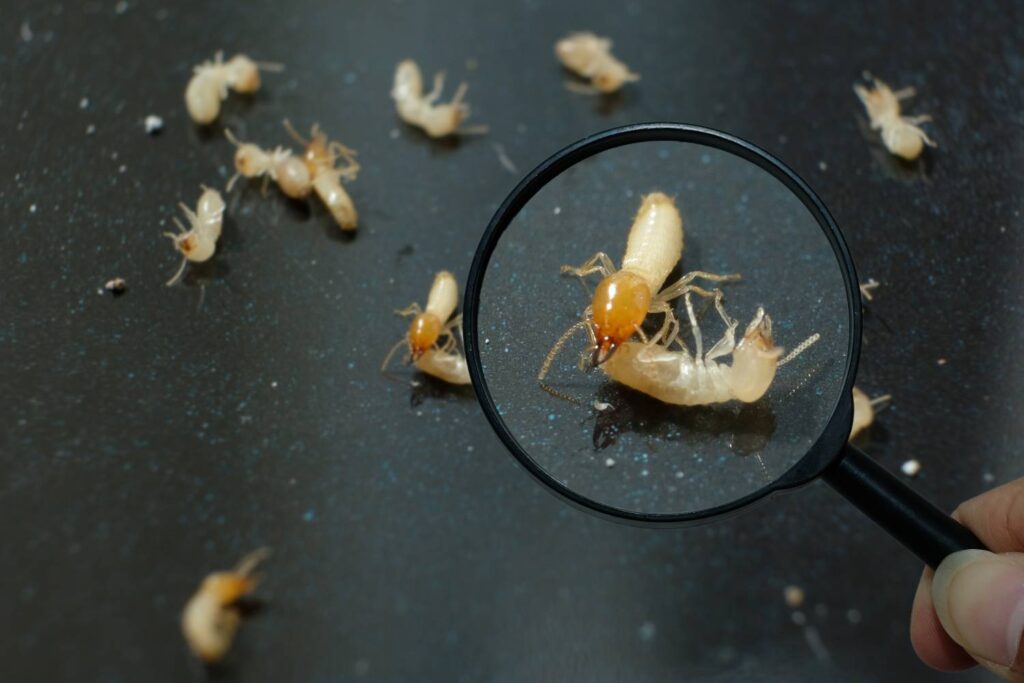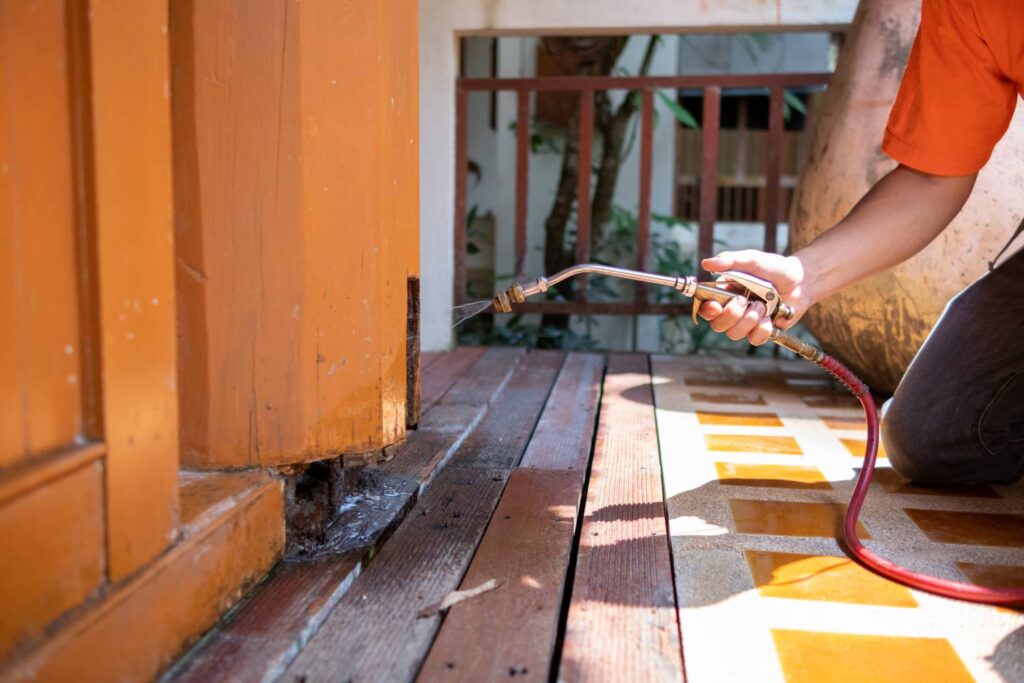During the warmer months, wasps, a common bug, can become a major nuisance around the house. Their stings can be excruciatingly painful, and they pose a threat to both humans and animals. In addition, picnics, barbeques, and other outdoor gatherings sometimes attract wasps due to the presence of sugary foods and drinks. Although they serve a useful purpose as pollinators and pest control, they will quickly become a nuisance if they decide to set up shop near or inside your home.
Wasp control is difficult but essential for avoiding injury from these insects. You can utilise wasp traps, apply insecticide, or call a professional pest control agency to eliminate them. However, these techniques should be used cautiously because of the potential risk to other insects and the environment. If pests are becoming a problem, call your local pest control professionals today! Wasps can be avoided by eliminating their food source, which can be done by covering food and drinks, cleaning up spills, and appropriately disposing of rubbish.
You are not alone in your fight against a wasp hive. This article explores options for humanely and efficiently eliminating wasps in your home. We'll discuss everything from do-it-yourself wasp zappers to the best exterminators. We'll also go over ways to avoid a wasp infestation by cutting off their food supply. If you follow the advice in this article, you won't have to worry about wasps invading your house or yard.
Identifying Wasps
Australia is home to numerous stinging wasp species. Large insects with a tapered "waist" and a pointed abdomen (that's where the sting is!) and warning colours (red, yellow, and black) characterise this group. Australia is home to three distinct wasp species:
Paper Wasps
Construct your nests from the undersides of branches and leaves or the eaves. Nests are typically modest (hosting no more than 100–200 wasps) and suspended on a stalk. They are not normally hostile and will only sting to protect their nest. Maximum 2.5cm in size.
Mud-Daubing Wasps
These giant solitary wasps construct a mud nest with several individual cells and attach it to the surface of a wall or ceiling. Before laying an egg and sealing each cell, females paralyse their prey (often a spider or caterpillar) and place it inside. They only sting in self-defence and are otherwise quite docile.
European Wasps
These yellow and black striped wasps may build massive nests with up to a hundred thousand individuals! Nests can be found in the ground (where the majority are located) and buildings (roof spaces, wall voids, and eaves), though the latter are less common.
They'll also make a home below uncovered piles of compost. Although the nest's combs of cells (like those of a honey bee) are usually hidden by a thick sheet of paper, they exist. Wasps native to Europe and Australia, the English wasp, are not dangerous to people unless provoked. However, many wasps can swarm at once and sting multiple times if they feel threatened. Approximately 1 to 1.5 centimetres in height.
What Are The Signs Of Infestation?
Pests, rats, and mould are some things that might cause an infestation. Of course, the telltale indicators of an infestation will change based on the kind of bug involved, but here are some general red flags to keep an eye out for:
Insects:
- Existence of bugs like cockroaches, ants, or bedbugs, either alive or dead.
- Bug poop, which could be dark brown or black.
- Insects' exoskeletons and egg casings.
- Damage to paper, plastic, or cloth caused by chewing.
- Odours that are hard to place, possibly brought on by the insects themselves or their excrement.
Rodents:
- Defecation, especially in damp, dark places or next to food.
- Teeth mark on cardboard, wood, and wires.
- Disconcerting sounds, typically heard at night, include scraping and scurrying.
- Nests are crafted from a variety of shredded materials.
- Rodents can use holes or cracks in the floor or walls to gain access.
Mould:
- Walls, ceilings, or other surfaces that have developed discolouration or black patches.
- A musty or earthy smell.
- Overt expansion, whether powdery, slimy, or hairy.
- Warping or staining caused by water.
- Sneezing, coughing, and itchy eyes are all signs of illness.
Infestation symptoms should be dealt with promptly to limit property loss and health hazards.
Can You Suggest Some Methods To Avoid Getting Stung By A Wasp?
Some advice on how to avoid being stung by wasps:
- If you're eating or drinking outside, cover your stuff. Sugary and sweet foods and drinks attract wasps, so keeping them out of reach is best.
- Keep outside trash can lids securely closed. Wasps are drawn to the scent of food and are more likely to explore your garbage cans.
- Close all the windows and doors. Wasps can enter a home through open doors and windows, so keeping those areas sealed off at all times is important.
- Close up the holes and crevices in your house's exterior. Wasps won't be able to get inside your home and make a nest there.
- Try to stay away from wearing anything too flashy. These may increase the likelihood that a wasp will sting you by attracting them.
- Maintain a neat lawn. Keep your yard neat and tidy to avoid wasp infestations, as they like to nest in overgrown foliage.
- Put up a wasp trap or spray to keep them away. You can use these items to discourage wasps from hanging about your house and yard.
How To Get Rid Of Wasp Nests On The Ground?
While we don't recommend doing it yourself, we recognise that professional pest control services aren't always accessible. How to safely and effectively eliminate a ground wasp colony is detailed below.
Make A Strategy.
You must have an exit strategy when attacking the nest. Know your surroundings and have a safe hiding spot ready.
Figure Out What Kinds Of Wasps You're Up Against.
Identification is crucial but can be difficult for the inexperienced eye. Yellowjackets, whose nests are typically found underground, are aggressive and pose a serious health risk if disturbed. If the nest has not been found, a thorough search of your property is in order.
Wear All Necessary Safety Equipment.
The right attire is required. Excellent used beekeeping gear. Buying one might be a good idea, depending on how often you see wasps. The clothing is the one thing standing between you and the wasps, so make sure it covers your entire body (including your head, face, hands, and feet).
Gather Pesticides.
Spray designed to destroy hornets is used on ground wasp nests.
The Wasp Nest Should Only Be Removed At Night.
Silently sneak up on the nest. The risk of being stung or assaulted by a wasp drops significantly after dark.
Approach The Nest Slowly.
Maintain the security of those close to you. Ensure everyone is outside and far away if you're in a secure location like a house.
Use The Wasp Spray On The Nest.
Be as quick as possible. First, the wasp nest needs to be emptied of the insecticide. Come back in a day and see if anything has happened. Spray again if you see any lingering wasps. If the nest is buried in the ground, wait until there is no sign of life before approaching it cautiously and covering it up with the earth. If the nest is within your home, you can remove it by knocking it into a trash bag, sealing it, and placing it outside.
The Wrong Way To Kill A Wasp Nest.
Dealing with a wasp nest could cause some people to act irrationally. Many examples have been of botched attempts to remove wasp nests throughout history. If you come across wasps, there are certain actions you should avoid taking.
The Wasps Can Be "Drowned" With Water
We see where you're coming from with this water thing, but something else is needed. Most of the wasps will escape as you pour water into the nest, at which point they will swarm and attack. Also, if the nest is inside your house, you risk hurting yourself and possibly causing expensive repairs.
Taking Down A Nest Of Wasps
One of the worst possible choices you could make. To begin with, the wasps in the area will likely start stinging if you get too close to their nest. And secondly, how far do you think that nest can travel? Finally, it would be best if you didn't consider it because you'll only provoke the wasps by knocking down their nest.
Starting a Fire in the Nest
Setting fire to the nest, like "drowning" the wasps above, may demolish the nest but will not necessarily kill all of the wasps in it. So don't use fire, especially if the nest is near your house; it could do much damage. After all, an exterminator should always be called before the fire department.
What Should I Do About A Wasp Nest In My Yard?
If you have young children or visitors who are allergic to wasp stings, attempting to remove a wasp nest from your home or yard is not advisable. The safest action is to call a pest control service immediately, as they will arrive with the necessary gear and protective clothing to deal with the wasp nest. If you approach or probe at the nest, the wasps become enraged. More helpful advice on how to stay safe can be found in the works listed below:
What to Look for to Determine Wasp Allergy?
Allergic reactions can vary in severity, from barely noticeable to life-threatening, such as anaphylaxis. Differentiating between the symptoms of the various stages is crucial. Wasp stings can cause a severe allergic reaction, and the most common symptoms include:
- Bruising and swelling of the face and neck.
- welts and itching all over, especially where stung;
- Issues with breathing;
- Stomach cramps
- Vomiting and Nausea;
- A significant drop in blood pressure;
- Dizziness;
- Loss of consciousness;
Your doctor can perform either a skin test or a blood test to establish if you have an allergy to wasp stings. Bees, hornets, yellow jackets, and European wasps are the most common forms of venom tested for by physicians.
The Blood Test
Although blood tests take longer, they are more accurate and carry less risk of injury (since the venom never actually touches the patient's skin). A little amount of blood will be drawn and sent to the lab for analysis by the doctor. If you have a confirmed allergy to wasp stings, getting bitten could be fatal. Therefore, it is recommended that you hire a professional pest control service to do away with the wasp nest for you.
The Skin Test
The total time required is about 15 minutes. After cleaning a location on the patient's arm or back, the doctor will apply the wasp venom before covering it. Allergic reactions to wasp stings include puffiness, redness, and discomfort.
Conclusion
Wasp infestations around the house can be a major problem due to the painful stings they can inflict. There are several methods for getting rid of wasps, including using traps, applying insecticides, or calling in professional pest control services. To prevent wasp infestations, it is important to cover food and drinks, clean up spills, and dispose of rubbish properly.
To avoid being stung by wasps, people should cover their food and drinks, keep windows and doors closed, and maintain a tidy lawn. To get rid of wasp nests on the ground, people should approach the nest slowly, wear protective clothing, and use wasp spray at night when the risk of being stung is lower. After waiting until there is no sign of life, the nest can be removed and placed in a sealed bag.
It is important to avoid incorrect methods for getting rid of wasp nests, such as starting a fire or attempting to remove the nest without proper protective equipment. If there are young children or visitors with allergies present, it is safest to call in professional pest control services.
Symptoms of wasp stings can include bruising, swelling, itching, breathing difficulties, stomach cramps, vomiting, nausea, a drop in blood pressure, dizziness, and loss of consciousness. A skin test or blood test can be performed by a doctor to determine if a person is allergic to wasp stings. The skin test involves applying wasp venom and observing any reaction.
Content Summary
- Wasps can be a major nuisance during warmer months, and their stings can be painful and pose a threat to both humans and animals.
- Wasps serve a useful purpose as pollinators and pest control.
- Wasps can become a nuisance if they decide to set up shop near or inside your home.
- Wasp control is difficult but essential for avoiding injury from these insects.
- You can utilise wasp traps, apply insecticide, or call a professional pest control agency to eliminate wasps.
- These techniques should be used cautiously because of the potential risk to other insects and the environment.
- Wasps can be avoided by eliminating their food source.
- Covering food and drinks, cleaning up spills, and appropriately disposing of rubbish are ways to eliminate the food source.
- This article explores options for humanely and efficiently eliminating wasps in your home.
- The article discusses everything from do-it-yourself wasp zappers to the best exterminators.
- Ways to avoid a wasp infestation by cutting off their food supply are also discussed.
- Australia is home to numerous stinging wasp species.
- Wasps are characterised by large insects with a tapered "waist" and a pointed abdomen, and warning colours (red, yellow, and black).
- Australia is home to three distinct wasp species: Paper Wasps, Mud-Daubing Wasps, and European Wasps.
- Paper Wasps construct their nests from the undersides of branches and leaves or the eaves and are not normally hostile.
- Mud-Daubing Wasps construct a mud nest with several individual cells and attach it to the surface of a wall or ceiling.
- European Wasps may build massive nests with up to a hundred thousand individuals and are located in the ground or buildings.
- Wasps native to Europe and Australia, the English wasp, are not dangerous to people unless provoked.
- The telltale indicators of an infestation will change based on the kind of bug involved.
- General red flags for an infestation of insects include the existence of bugs like cockroaches, ants, or bedbugs.
- Bug poop, exoskeletons, and egg casings are also indicators of an infestation.
- Damage to paper, plastic, or cloth caused by chewing is a sign of an insect infestation.
- Defecation, teeth marks, and nests crafted from shredded materials are indicators of a rodent infestation.
- Walls, ceilings, or other surfaces that have developed discolouration or black patches are signs of a mould infestation.
- A musty or earthy smell, expansion, warping or staining caused by water, sneezing, coughing, and itchy eyes are all signs of a mould infestation.
- Infestation symptoms should be dealt with promptly to limit property loss and health hazards.
- To avoid being stung by wasps, it is advised to cover sugary and sweet foods and drinks when eating or drinking outside.
- Keep outside trash can lids securely closed to avoid attracting wasps.
- Closing all windows and doors, sealing off holes and crevices in the house's exterior, and maintaining a neat lawn can also help avoid a wasp infestation.
- Wearing anything too flashy may increase the likelihood of getting stung by a wasp.
Frequently Asked Questions About Wasps
Wasps are attracted to certain smells like sweet and sugary scents, but there are also smells that they dislike and may avoid. Here are some smells that are known to repel wasps:
- Peppermint: Wasps are repelled by the strong scent of peppermint oil. You can try spraying peppermint oil around areas where wasps are present or use peppermint oil-based products.
- Citronella: Citronella is a natural insect repellent that can also repel wasps. You can burn citronella candles or use citronella essential oil in a diffuser.
- Eucalyptus: The strong scent of eucalyptus oil can also repel wasps. You can use eucalyptus oil in a diffuser or spray it around areas where wasps are present.
- Garlic: Wasps dislike the smell of garlic, so you can try placing cloves of garlic in areas where wasps are present or spray garlic juice around those areas.
- Vinegar: Wasps are also repelled by the strong smell of vinegar. You can mix equal parts of water and vinegar in a spray bottle and spray it around areas where wasps are present.
It's important to note that while these smells may help repel wasps, they may not be 100% effective and should not be relied upon as the sole method of wasp control. If you have a serious wasp infestation, it's best to call a professional pest control service to safely and effectively remove the wasps.
There is no specific color that has been proven to calm wasps. In fact, wasps are not attracted to colors in the same way that bees are attracted to flowers. Wasps are more attracted to sweet and sugary scents than they are to colors.
That being said, it is generally a good idea to avoid wearing bright, floral or patterned clothing when you are outside, especially if you are in an area where wasps are present. This is because these types of clothing can resemble flowers and attract the attention of wasps.
It's also important to avoid swatting at or agitating wasps, as this can make them feel threatened and more likely to sting. If you need to move past a group of wasps, try to move slowly and calmly, without making sudden movements or noises. This will help to avoid attracting their attention and reduce the likelihood of being stung.
If a wasp lands on you, don't flap at it or try to brush it off – it will sting you. Just stay still and let it fly off in its own time. A wasp trapped in clothing is more difficult to deal with because any slight movement can press garments against it.
Always remain still if a wasp approaches you. If you have to run away, do so in a straight line, without flailing your arms. Protect your head and face, as these areas are mostly likely to be targeted by the wasps.
Unlike bees, which can only sting once and then die, wasps are capable of stinging multiple times. Female wasps have a stinger at the end of their abdomen that they can use to defend themselves or their colony. When a wasp stings, it injects venom into the skin, which can cause pain, swelling, and other allergic reactions in some people.
A wasp can sting repeatedly as long as it feels threatened or agitated. However, a wasp will usually only sting in self-defense or to defend its nest, so it's important to avoid disturbing or provoking wasps whenever possible. If you do encounter a wasp and it begins to act aggressively, it's best to move away slowly and calmly without making any sudden movements.
If you are stung by a wasp, it's important to clean the area with soap and water and apply a cold compress to reduce swelling and pain. If you experience symptoms such as difficulty breathing, swelling of the throat or tongue, or dizziness, seek medical attention immediately, as these may be signs of a severe allergic reaction.

